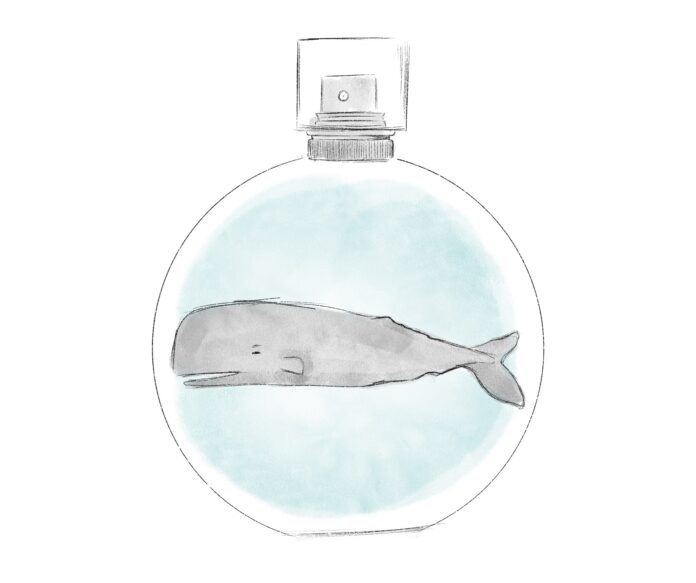When you think of perfume, what kinds of ingredients come to mind? Some people may think about flowery scents like rose, cherry blossom, or jasmine. Others may think of sweet notes vanilla, cinnamon, or honey. For some, the note “ambergris” may come to mind, but what is it? It can be described as a unique, musky scent with hints of the ocean. The original scent is actually derived from the intestines of sperm whales. How in the world would part of an animal’s digestive system end up in a perfume bottle?
History of Ambergris
According to the Smithsonian Museum, ambergris is a waxy substance that can only be found in the bowels of sperm whales, and it can only be collected if the whale regurgitates or defecates it (Brito, Jordão & Pierce, 2016). In other words, the scent comes directly from sperm whale intestines, where food is digested and turned into waste. The idea of the substance coming from intestines can certainly be off-putting. After all, the substance comes from the same place that feces are made in the whale.
Despite such an unappealing origin, ambergris was actually beloved throughout history. It was used by a multitude of cultures, ranging from Egypt to Europe. Ancient Egyptians burned the substance as incense to ward off evil spirits, Arabic regions used it as medicine, and some people in medieval Europe even consumed it in luxury dishes (Olson, 2024). Evidently, ambergris had many different uses throughout history. It was even described to have a sweet, musky scent with “notes of tobacco, sandalwood, and ocean” that got better with age (Olson, 2024). Thus, it makes sense that the fatty gold somehow found its way into the perfume industry.
Animal Products in Perfume
At first glance, hearing about animal parts in perfume may sound alarming. However, animal products were commonly used in perfumes before chemists could synthetically recreate those scents. For instance, many common perfumes found in beauty stores will often have “musk” listed as one of the key notes. Musk actually comes from a sac in the musk deer, which is then removed and excreted to make perfume. (Fortneau, 2004). Thus, it was not necessarily a strange practice to implement the secretions of different animals into perfume. In fact, the same ambergris was originally used in Chanel No.5, utilizing the ambrein alcohol found within ambergris to help enhance the other scents within the perfume (Olson, 2024).
Is it Still Used Today?
If there are any perfumes that contain the scent of ambergris in modern times, chances are the scent is synthetic. This is due to the fact that whale poaching is now illegal in most countries. In fact, it is illegal to even sell the ambergris in certain countries because the sperm whale is considered an endangered species due to the over hunting of the animal in the past (Olson, 2024). In order to emulate the same scent while keeping wildlife safe, chemists have found ways to replicate similar scents to those made with animals synthetically.
For instance, it was previously discussed that the scent “musk” originally came from the musk deer. However, it would likely cause harm to the population if the deer were to be hunted to satiate the demand of the perfume industry. Thus, chemists can replicate the scent by creating synthetic compounds that are chemically similar to what gives each note its specific scent. For musk, the main component that gives it its scent is called muscone. This was replaced by “musk Baur”, a scent that was discovered by Albert Baur when experimenting with trinitrotoluene (TNT) and “tert-butylhalides” to create new explosives (Fortneau, 2004). Today, chemicals like musk Baur are used much more often because they are much cheaper than hunting the animal themselves.
This way, endangered species can be kept safe from hunting, while people can still enjoy the scents they love – even if they do come from the innermost parts of a whale.
References
Brito C, Jordão VL, Pierce GJ. (2016). Ambergris as an overlooked historical marine resource: its biology and role as a global economic commodity. Journal of the Marine Biological Association of the United Kingdom. https://doi.org/10.1017/S0025315415000910
Fortneau, AD. (2004). Chemistry Perfumes Your Daily Life. Journal of Chemical Education. American Chemical Society. https://doi.org/10.1021/ed081p45
Olson, D. (2024). The Mystery of Ambergris. Smithsonian National Museum of Natural History. https://ocean.si.edu/ocean-life/marine-mammals/mystery-ambergris
